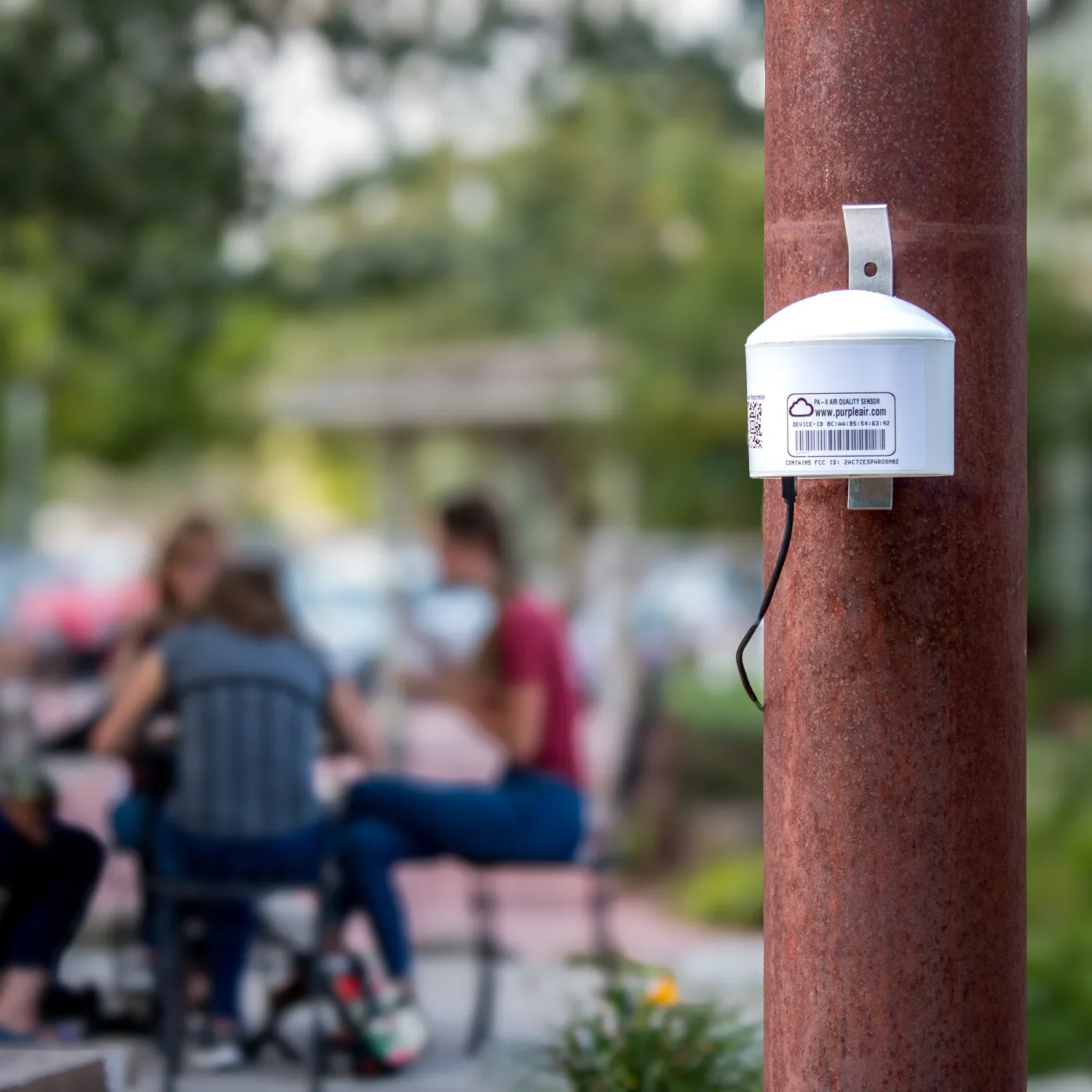Pollution Sensors: The Next Step in Improving Chicago’s Air Quality with N4EJ
Photo by Heather B on Pexels
In August, the City of Chicago announced it is launching a citywide network of 277 high-quality air sensors with the goal of creating the largest pollution monitoring system in the U.S. The initiative is led by the city in partnership with the University of Illinois Chicago and the Chicago Public Health Department, supported by government and private grants.
Officials noted the sensors will not be used to enforce better air quality standards for now, but guide planning, zoning, industrial siting, and public health protections in the future—particularly in neighborhoods on the Far South, Southwest, and West Sides.
These areas of Chicago have long struggled with air pollution driven by traffic, industrial facilities, and regional smoke events like wildfires, leading to disproportionately worse air quality and health impacts than for other parts of the city.
The Clarity sensors are more advanced than standard low-cost devices, allowing more granular, real-time mapping of particulate matter and other pollutants. Over time, this data will better reveal pollution hotspots, track trends, and provide evidence to push for stronger community safeguards. Officials hope the publicly available data will empower residents and improve decision-making on industrial permitting, urban planning, and environmental justice policies.
Advocacy for safer, cleaner air runs deep in Chicago communities, notably in the neighborhoods on the South and West sides that experience the impacts of air pollution the most. Some residents in McKinley Park, in response to such impact, formed the Neighbors for Environmental Justice (N4EJ), centralizing the community’s environmental reformation efforts for a safer, healthier city.
On the Ground: Neighbors for Environmental Justice (N4EJ)
N4EJ staff and supporters. Photo Credit to N4EJ Facebook Page
N4EJ works to make Chicago’s neighborhoods healthier by challenging polluters and pushing for stronger protections. They were founded in response to the MAT Asphalt plant constructed in McKinley Park and continue to organize residents to report odors and pollution. The group engages in legal and policy advocacy to strengthen environmental enforcement, and publishes reports highlighting gaps in city oversight. N4EJ also partners with other grassroots groups through the Chicago Environmental Justice Network to fight environmental racism and advance cleaner, safer development citywide.
Most recently, N4EJ is working toward passing the Hazel M Johnson Cumulative Impacts Ordinance, which will strengthen the zoning review process for high-pollution industries and require them to thoroughly assess their impacts on vulnerable communities. Chicago Environmentalists is supporting this effort as one of its key policy priorities, as you may have seen on social media. It has passed in City Council, but the ordinance is now with the Chicago Zoning Committee for further review and approval.
Years prior to the City of Chicago’s efforts, N4EJ set up a community-based air monitoring system with PurpleAir sensors, the data of which can be publicly accessed via their website.
Chicago Environmentalists sat down with Alfredo Romo, Co-Founder and Executive Director of N4EJ, to dive deeper into their on-the-ground efforts to install the air pollution sensors, and what residents can do to stay informed and active on the subject.
A Conversation With N4EJ
Q: What motivated N4EJ to begin installing your own air monitors in Chicago? Was there a particular incident, health concern, or lack of data that triggered it?
A: N4EJ started installing air monitors in McKinley Park after the MAT Asphalt facility suddenly showed up across the street from a park, right next to the National Latino Education Institute. We wanted to be able to gauge the impacts of the facility by getting data from before and after they started operating, so we started installing PurpleAir monitors before they even started producing asphalt.
Unfortunately, there are notable gaps in air monitoring resources in Chicago in the places that need them the most, which was another reason N4EJ started installing PurpleAir monitors in 2018.
Image Credit: PurpleAir
Image Credit: PurpleAir
Q: How did you select the locations for the first sensors on the southwest side? What factors did you consider?
A: The very first sensors that were installed were meant to measure the impacts of a hot-mix asphalt facility on the places around it. Therefore, it was hyper-local to McKinley Park.
Q: How do the pollution levels you measure compare to citywide or even regional/state/federal levels?
A: We have not yet done any sort of comprehensive data analysis to answer this question, but we do know that PM2.5 levels trend higher in SW Chicago compared to the rest of the city and that Chicago ranks the 13th worst for annual particle pollution compared to other metropolitan areas according to the American Lung Association.
Q: What kind of sensors are you using? What pollutants do they measure, and are there limitations to what they can measure?
A: They are PurpleAir Flex sensors, and they measure PM2.5 (fine particulate matter), VOCs (stands for volatile organic compounds and refers to a variety of gasses that can be harmful to human health).
There are limitations to what this sensor can measure because it’s a low cost-sensor that’s built to be accessible. PurpleAir monitors are helpful for measuring hyperlocal conditions that the EPA monitors don’t cover, and the EPA uses data from these monitors in their AirNow Fire and Smoke map for this reason. This particular monitor has been proven to generate reliable readings of PM2.5. There are limitations to the data about VOCs, because the sensor meant to read them is still in an experimental phase and, in general, it’s challenging to measure gases for a variety of different reasons.
Q: What pollutant metrics do you think are most meaningful for residents and why?
A: I think that PM2.5 is an important pollutant to measure because it refers to the many different types of tiny bits of stuff that we breathe that are far too small to see. One PM2.5 particle is approximately 1/100th the size of a strand of human hair. Though these particles can be a combination of many different things, it’s still a good indicator of the presence of unhealthy pollutants. High amounts of PM2.5 can cause both short-term and long-term health effects.
Q: How can residents use the data you provide to advocate for cleaner air or influence local policy?
A: Residents can use the data from these monitors as another way to understand the everyday pollution concerns that we face in heavily affected areas alongside what our senses and bodies tell us. We can take action on days when the readings are high by encouraging sensitive populations to stay indoors and wear masks outside. We can also learn from the trends that we see over time and use this data to engage with local government while we’re advocating for increased protections from current polluting industries and any possible future developments.
Getting Involved: Why it Matters
Clean air isn’t just an environmental issue—it’s a public health necessity. Air pollution has been linked to asthma, heart disease, and other chronic conditions, with long-term exposure causing lasting harm to families and communities.
In Chicago and beyond, these impacts are not felt equally. Low-income, Black, and Hispanic neighborhoods are often located closest to industrial facilities and high-traffic corridors, meaning residents shoulder a disproportionate burden of poor air quality. A 2020 Air Quality and Health Report from the City of Chicago underscores that in some of these vulnerable communities, the risk of heart disease and chronic obstructive pulmonary disease can be ten times greater than in other neighborhoods within our city.
Vigilance matters: without consistent community action, these inequities will persist. Thanks to efforts from N4EJ, there are ways for residents to get involved easily and contribute to Chicago’s enhanced air quality efforts.
Image from Midwest Comprehensive Visualization Dashboards: The Image of an Overburdened Community. Image credit to L. Johnson and M. Cailas, via UIC. Full text and graphics can be found HERE.
Suggest A Location for Air Pollution Sensors
Have a suggestion for where you want air pollution sensors to go next? N4EJ provides the ChicagoAQI online tool that allows anyone to submit suggestions, which will then be forwarded to the City of Chicago’s Department of Public Health. Your input is valued and provides important data for the department to move forward with enacting positive community changes.
Report A Change in Air Quality
Notice a significant change in air quality in your area? Any particularly bad smells? Report it to N4EJ’s Air Pollution Complaint form, and file a complaint with the city on Chicago’s 311 webpage.
Learn More about N4EJ and their Work
By engaging in air monitoring, advocacy, and education, groups like Neighbors for Environmental Justice are showing that everyday residents have the power to hold polluters accountable and push for healthier, safer neighborhoods. The City of Chicago’s move to launch its own sensor network reflects and builds on the work that grassroots organizations like N4EJ began years earlier, demonstrating that community-driven solutions can spark citywide change. Protecting our air quality means protecting our future—and everyone has a role to play. To learn more and take action alongside N4EJ, visit their Get Involved page.
ARTICLE WRITTEN BY
Sophie Shulman, Blog Manager & SEO Specialist for the Chicago Environmentalists







